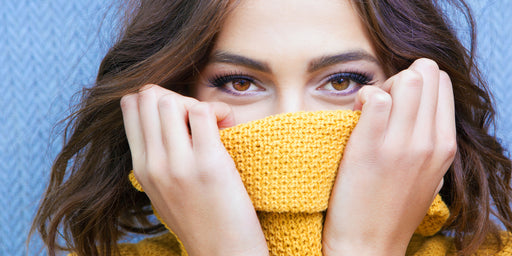How To Unshrink Merino Wool

If you’re here because you just want to learn what to do in case the unthinkable happens - great! But, if you’re here because the unthinkable has already happened and you accidentally washed a wool sweater and your garment has shrunk, don’t worry - there’s still hope. First, we’ll explain some of the ins and outs of this unique natural fibre, which will then help you understand the reason behind each step in our guide to unshrinking your merino wool clothing.
How Do We Get Merino Wool?
As with many natural fibers that come from animals, the name we use for the fabric indicates a particular breed of animal. In this case, a breed of sheep - thought to have originated in Morocco - found in southwestern Spain. Prior to the 18th century, it was hard to find flocks of Merinos outside of Spain as it was a crime that could result in a death penalty.
Now, you can find Merino sheep bred the world over. Their evolution as a domesticated breed now means their wool never stops growing, meaning these sheep must be shorn once a year, at least, to prevent them from overheating, blindness and other health issues. However, you do still hear the occasional story of a rebel sheep showing up after years lost in the countryside, completely overgrown but otherwise healthy.
What Makes Merino Wool So Special?
Good quality merino wool is soft to the touch and incredibly comfortable when worn against the skin. In fact, many merino wool garments are made to be worn as layers beneath other types of clothing, often for use in environments where temperatures may be extreme or change rapidly. That’s because merino wool can multi-task - it can keep you warm and it can cool you down.
The bends in each hair create vented layers that trap warm air. And, if we start to perspire, the wool ‘wicks’ the moisture away. That means the wool absorbs your body’s sweat and releases it as a vapor. Other clothing can trap your perspiration against your skin, which prevents your body from actually benefiting from the cool-down the sweat is supposed to bring you by evaporating off of your skin.

But, you should know that not all merino wool comes from the same strain of Merino sheep - and that means a lot of variance in quality between different regions and textile manufacturers. Merino sheep may also be bred for mutton and the wool they produce isn’t viable for textile production. Still, if someone did manage to knit a sweater out of it, they could still say it’s 100% merino wool and they wouldn’t be wrong. Realities like this mean you should purchase your merino wool garments from trusted retailers.
Know Your Wool: Merino vs Other Common Types
So how does merino wool stack up compared to other common types of wool? While that does depend on your reasons for buying a wool garment, there are certain factors that make merino the preferred wool type for a variety of uses.
Is Merino the softest wool?
No. There’s no denying that good merino wool has a supple, delightful feel - but it’s nowhere near the softest wool you can find, and that’s taking into consideration how differently anyone might interpret “softness”. The length of a strand of hair and its thickness are good indicators of how soft any given wool garment might be. For softer wools, you’ll want to consider cashmere, angora or even lamb’s wool.
Is Merino the warmest wool?
No. But, since this can depend on how a person actually feels while wearing any given garment, it’s hard to say for certain. But, wools made from certain types of oxen found in the arctic produce garments believed to retain heat much better than many other common types of wool. However, textiles like these may only be suitable for outerwear garments, whereas merino wool is comfortable enough to wear close to the skin.

Is Merino the most expensive wool?
Your wallet will definitely feel a bit of sting when it comes time to buy good quality merino wool and merino wool clothing, but it’s not the most expensive type of wool out there. Antique rarities aside, the Peruvian vicuna, an animal related to the alpaca, produces the most expensive type of wool in the world. Vicuna’s are closely protected and exclusive to Peru.
If merino wool isn’t really the best or most valuable wool in any of these categories, then why is it so popular? It’s a fair question and has an equally fair answer - it’s usually the best balance between comfort, function and cost when compared to every other type of wool.
Best Practices: How to Wash Merino Wool
If this is your first time washing a wool garment, make sure you review our in-depth guides on how to hand-wash or machine-wash your favorite pieces. Here’s a quick review of what you need to keep in mind every wash to avoid shrink:
- Start fresh. If you’re using a tub, sink or bucket, then you need to make sure they’re free of anything that could stain or damage your merino wool. Even if you can’t see anything, it’s best to fully wash and rinse the area before you start hand-washing. In a machine washer, make sure to run an empty rinse cycle if you used bleach or harsh chemicals in the cycle prior.
- Stay cool. As much as possible, keep your wool garments away from heat sources - that means don’t use hot or warm water when you wash and rinse, and don’t leave your garment out to dry near a vent or radiator.

- Wash merino wool gently. That means gentle soap and gentle agitation. You should never scrub or stretch your merino wool when you wash your merino wool. Swirling the water around it gently can help circulate things if you want to make sure you’re cleaning the piece thoroughly.
- Rinse thoroughly. Don’t let that gentle hand cause you to leave behind remnants of soap. Even though wool-safe detergents don’t have any harsh chemicals, any soap can still leave a residue that impacts the integrity of a textile. Diluted vinegar rinses can help reduce product build-up, too.
- Dry carefully. Just as you should never stretch wool when washing and rinsing it, you should never let it hang dry. The weight of the garment will cause it to lose its shape by stretching out too much in some areas and shrinking up in others. Make sure your garment dries completely before you put it into storage, too, to avoid long-term damage or an increased risk of clothes moth infestation!
How To Unshrink Merino Wool Clothing
If you’re desperately wondering if there’s any way to unshrink merino wool after washing, you’ve come to the right place. Maybe you forgot to separate your laundry and your favorite merino wool leggings wound up going through a regular wash and dry cycle and now you have a pair of baby trousers. Maybe your roommate thought they were doing you a favor by tossing your wet wool socks in the dryer and now you’ve got a new muff for your big toe. Whatever the case may be, all the steps are more or less the same:
Step 1.
Fill a tub or sink with lukewarm water.
Moisture, heat and agitation are the three main culprits behind shrinking merino wool - but we can use some elements of those factors to reverse the shrinking process, too.
Step 2.
Dissolve a generous amount of conditioner in the water.
You can find wool-specific conditioners that are made to help with this process, but many people use their own hair conditioner. It can also help emulsify the conditioner and water together if you add a bit of your usual detergent.
Step 3.
Allow the merino wool garment to soak for several minutes.
You should definitely help this along by squeezing the garment so that the conditioner can move through every layer properly. A 20-minute soak should be long enough. Take note: you will not be rinsing the garment as your next step! That comes later.
Step 4.
Squeeze out extra water, then lay flat on a towel.
If you’re working with a piece that’s bigger than your biggest towel, you can use a sheet or a blanket. You should also have another one to layer over top so that you can squeeze out all the excess water.
Step 5.
Reshape, then repeat as needed.
After you’re done squeezing out water, you’ll need to work in careful, proportionate sections to stretch your garment back to its original shape. You should do this incrementally and in stages before the garment dries completely. Do not use clips or weights to hold any part of the garment in place.

Step 6. Wash your merino wool and dry again.
Once you’re satisfied with the reshaping and the garment has completely dried, you will need to wash the remnants of conditioner out of it before you can wear or store it again. Be careful to use only cool water and dry the garment flat, away from heat and light sources.
Now you’re ready to save the day if you wind up with shrunken merino wool clothing. Just remember to take it slow and stretch carefully!
Don't forget to protect your merino wool clothing with an effective Clothes Moth Pheromone Traps.
Our article on cashmere vs wool gives you plenty of information about the differences between these two fabrics.
About MothPrevention
MothPrevention® speak to customers every day about their clothes moth issues - clothes moths are a species that are ever increasing and that can cause significant damage to clothes, carpets and other home textiles.
To date, we’ve helped over 250,000 customers deal with their moth problems. We have developed professional grade solutions including proprietary pheromones and trap design, not available from anybody else in the USA.





